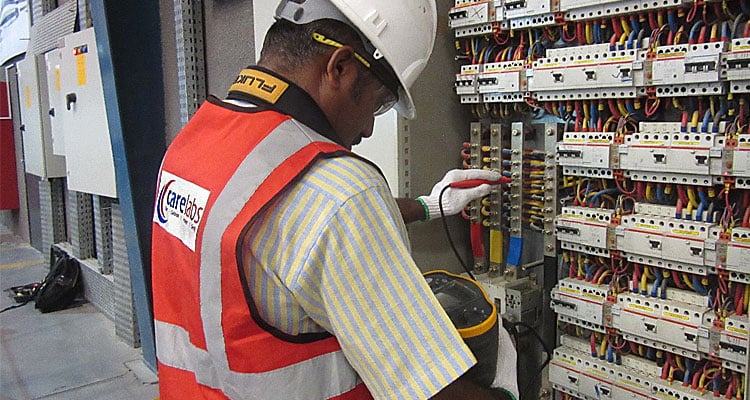Electrical Safety Auditing

Carelabs have accredited HV, MV, and LV auditors available to assist with your HV, MV, and LV Installation Inspections. Statutory Audition is done to ensure the safe operation of the installation and to comply with the legislation, rules and guidelines. Carelabs provide audit guidelines for large projects to avoid unexpected delays in the auditing process, and to advise what documentation and inspections will be required.
Carelabs is authorized provider of Electrical Installation’s Study, Analysis, Inspection, and Certification services in UAE, and offer electrical safety audit service in UAE.
Why is Electrical Safety Audit/Inspection Necessary?
Electrical hazards continue to threaten safety of people and property in the form of shocks, burns, injury, fire and explosion. With electricity having become an indispensable part of our life, electrical risks are to be managed effectively.
In process industries, fires due to electrical reasons are very probable, especially in industries that handle flammable chemicals. In service industries such as information technology, telecommunications, banking and other commercial establishments, business interruption losses due to electrical hazards (fire in server room, damage of expensive communication equipment, loss of data, fire in cable gallery, etc.) could be substantial. An Electrical safety audit is the solution.
Electrical Safety Audit Objectives
- To present the current status of the facility before the top management
- To evaluate potential hazards and to recommend suggestions for improvements.
- Diagnose Various on-going losses in the facility
- Identifying deterioration of standards, areas of risks or vulnerability, hazards and potential accidents in plants
- Determining actions to minimize hazards
- Recommend Measures for Improvement and Electrical Safety
- Ensure that safety effort is effective & meaningful
In short, An Electrical Safety Audit is a loss prevention program, prevent loss of productivity, property and prevent loss of life or prevent injuries.
At Carelabs comprehensive Electrical Safety Audit is conducted by experienced electrical engineers who assist clients in reducing risk, make use of standard operating procedures of electrical equipment, and help to ensure compliance with applicable Safety Standards and Regulations.
Typical Scope of Electrical Safety Audit
For a typical small to medium-sized location, thorough electrical safety audit can take 3-5 days, while sometime taking up to 1-2 weeks for report writing as required. A larger facility may take two to three weeks for an audit, especially at sites that have an unusually large number of electrical employees (150 or more). The process involves a full review of electrical program records, including training schedule, qualification, electrical maintenance, and self-assessments.
- Verification of statutory compliance with respect to local and international codes & guidelines
- Physical inspection to identify electrical hazards (shock, fire, explosion, physical damage) and to suggest electrical safety solutions
- Review of plant lightning protection system (need, adequacy, installation and maintenance)
- Review of static electricity hazards in the plant operations (if applicable)
- Review of hazardous area classification and selection of flame-proof electrical equipment in the plant, including maintenance aspects (if applicable)
- Review of hand tools and Personal Protective Equipment (PPE) being used by the factory employees
- Review of electrical preventive maintenance system (including tests, documentation, history cards, etc).
- Review of electrical accidents and near misses in the plant to identify the root causes
- Review of electrical systems & procedures (work permits, interlocks, lockout tags, etc).
- Review of the importance given to electrical safety in the company safety policy, safety committee, continuous electrical risk identification, etc.
- Assessing the integrity of insulation of cables by carrying out insulation resistance tests on a sample basis
- Review of the earthing system (installation & maintenance aspects), including sample earth resistance tests
- To identify areas of overloading by carrying out load current measurements and compared against cable current carrying capacity calculation
- Identification of gaps and gap analysis
- OSHA / NFPA 70E Arc Flash & Electrical Safety Compliance
- Assured Equipment Grounding
- Ground Fault Circuit Interruption Protection
- Lock Out / Tag Out
Electrical Safety Audit Process
The following electrical safety audit structure is prepared for developing electrical safety program to be implemented. The data collection and analysis can be conducted in modular way.
- Pre-Audit & Coordination Meeting
- Pre-Audit Questionnaire
- Checklist with reference to Statutory regulations
- Physical Inspection
- Conducting Test and Measurement
- Discussion with Safety & Electrical personnel
- Examination & Review of Records/ Document
- Draft Report Preparation
- Review Meeting with Management
- Final Report Submission
Electrical Safety Audit Final Report Will Contain
- Introduction
- Executive Summary
- Preface to Electrical Safety Audit
- Observations and Recommendations
- Lightning Protection System Evaluation
- Electrical Hazards and Control Measures
- Hazardous Area- Observations & Recommendations
- Review of Electrical Accidents and Control Measures
- Review of Fire Hazards and Protection Measures
- Electrical Maintenance Review
- Review of Electrical Test Records & Test Procedures
- Report
Benefits of Electrical Safety Auditing
- Prevent loss due to electrical hazards
- Insurance compliance
- Compliance with statutory regulations, and follow safety standards
- Increased levels of safety
- More efficient use of resources
- Clarification of electrical safety responsibilities
- The identification and elimination of safety hazards
- Ensuring longevity of your expensive electronic equipment like computers and other machines
- Ensure peace of mind in your client’s mind that their valuable information like data and other documents is safe from electrical hazards
- Improvement of employee morale
- Development of a dynamic record of safety performance
- Creation of positive cycle of safety improvement
- Improvement of management awareness of electrical related problems
- Ensuring compliance with Government and industry safety related work practices
Related Services
3rd Party Inspection Of Electrical Installation
Third Party Electrical Certification
Electrical Installations Certification
Electrical Switchgear Safety Inspection
Commercial Electrical Inspection
Biomedical Equipment Safety Inspection
Building Envelope Thermography Inspection
Electrical Installation Inspection To Procure OFC
Relay Coordination Study & Analysis
